Zeiss Sonnar 50mm F/2 - regular Versions and Specs
This page contains an overview of all regular versions of the Zeiss Sonnar 5cm f/2 and some of its derivatives. Further below you can find a detailed description with photos of each version. You can find more information on the history or the optical design and relevance of the Sonnar in other posts here. There is also another overview of all regular versions of the Zeiss Sonnar 5cm f/1,5.
Spec Sheet
Detailed Description
TOC
- [v1b ZJ CR bnA2] 1932 Carl Zeiss Jena Contax black nickel A-shape F/22
- [v1b ZJ CR bnX2] 1932 Carl Zeiss Jena Contax black nickel X-shape F/22
- [v1b ZJ CR bnV6] 1932 Carl Zeiss Jena Contax black nickel V-shape F/16
- [v2b ZJ CR bnV6] 1933 Carl Zeiss Jena Contax black nickel V-shape F/16
- [v3b ZJ CR bnV2] 1933 Carl Zeiss Jena Contax black nickel V-shape F/22
- [v3b ZJ CR bnU] 1934 Carl Zeiss Jena Contax black nickel U-shape F/22
- [v3b ZJ CF c3] 1934 Carl Zeiss Jena Contaflex chrome 13 aperture blades
- [v3b ZJ CR br] 1935 Carl Zeiss Jena Contax black ring nickel F/22
- [v3b ZJ CR cO] 1935 Carl Zeiss Jena Contax chrome diagonal F/22
- [v3b ZJ CF c] 1935 Carl Zeiss Jena Contaflex chrome 9 aperture blades
- [v3b ZJ CR ccCF] 1935 Carl Zeiss Jena Contax chrome collapsible high head F/22
- [v3b ZJ CR cc] 1935 Carl Zeiss Jena Contax chrome collapsible flat head F/22
- [v3b ZJ CR ccT] 1936 Carl Zeiss Jena Contax chrome collapsible T F/22
- [v3b ZJ CF cf] 1936 Carl Zeiss Jena Contaflex chrome flat head
- [v3b ZJ CR ac] 1939 Carl Zeiss Jena Contax aluminum collapsible flat head F/22
- [v3b ZJ CR acT T] 1940 Carl Zeiss Jena Contaflex aluminum collapsible transition T F/22
- [v3b ZJ CR acT] 1940 Carl Zeiss Jena Contax aluminum collapsible flat head T F/22
- [v3b ZJ SP sT] 1941 Carl Zeiss Jena Super Parvo
- [v3b ZJ LT ac] 1940 Carl Zeiss Jena LTM aluminum collapsible F/22
- [v3b ZJ M7 bg] 1945 Carl Zeiss Jena M27 black geared Bakelite F/22
- [v3b ZJ CR accT T] 1946 Carl Zeiss Jena Contax aluminum collapsible flat head transition F/22
- [v3b ZE CR abbb] 1947 Carl Zeiss Jena Contax aluminum black arrow, block pin, black mount
- [v3b ZE CR arrs] 1947 Carl Zeiss Jena Contax chrome red arrow, red dot pin, silver mount
- [v3b ZE CR arrb] 1948 Carl Zeiss Jena Contax aluminum red arrow, red dot pin, black mount
- [v3b ZE CR abrb] 1948 Carl Zeiss Jena Contax aluminum black arrow, red dot pin, black mount
- [v3b ZE CR irrb] 1948 Carl Zeiss Jena Contax Ivory aluminum red arrow, red dot pin, black mount
- [v3b ZE CR arrb0] 1950 Carl Zeiss Jena Contax aluminum red arrow, red dot pin, black mount 50mm
- [v3b ZE CR arrs0] 1950 Carl Zeiss Jena Contax chrome red arrow, red dot pin, silver mount 50mm
- [v3b ZE KF b] 1952 Carl Zeiss Jena KEF
- [v3b ZE KF bY] 1952 Carl Zeiss Jena KEF 551702
- [v4b ZO CR sot2] 1950 Zeiss-Opton Contax silver rim T 12 aperture blades
- [v4b ZO CR sot1] 1952 Zeiss-Opton Contax silver rim T 11 aperture blades
- [v4b ZO CR bot] 1952 Zeiss-Opton Contax black rim T 11 aperture blades
- [v4b ZO CR bo] 1953 Zeiss-Opton Contax black rim
- [v4b ZO CR bz] 1954 Carl Zeiss Contax black rim
- [v4b ZO RR b] 1955 Carl Zeiss Robot Royal black rim
- [v4b ZO CR bzR] 1955 Carl Zeiss Contax black rim Robot head
- [v3b ZK CR ZK] 1948 KMZ ZK P Contax
- [v3k VD CR j8mbr0] 1974 VALDAI Jupiter-8M Contax
[v1b ZJ CR bnA2] 1932 Carl Zeiss Jena Contax black nickel A-shape F/22
-
black
and nickel finish with Contax
Rangefinder mount
- name ring: Carl Zeiss Jena Sonnar 1:2 f=5cm Nr
- filter rim: nickel and black, no filter thread, uses 37mm push on filters
- grip ring: black rippled, very narrow
- aperture mark: white dot
- aperture ring: half nickel and black, top silver (nickel) with black aperture scale, diagonal 16 & 22 line, bottom half with black rippled grip ring, clickless
- locking plate: red dot
- mount: nickel
- aperture markings 2 - 22
- uncoated optics
- v1b optical lens calculation
The first Sonnar 5cm F/2 was released by Carl Zeiss Jena in Summer 1932. It was the first 5cm full frame lens by Zeiss and at that time the brightest 5cm / 50mm full frame lens of the world. It was released a half year before the release of its even brighter brother the Sonnar 5cm F/1,5. Both lenses were created by Ludwig Bertele for Zeiss Ikon in Dresden (Germany) to fit the new Contax camera that was secretly developed by Zeiss Ikon in Dresden.
The design matched the black and nickel look of the new Zeiss Ikon Contax I camera. It featured the new interchangeable lenses Contax Rangefinder (CRF) bayonet mount.
As a standard lens it used the internal CRF bayonet but has no focus ring or focusing helicoid. It depends on the camera (or adapter) for moving the lens to the right focus distance. Because of this design all CRF Sonnars are very small compared to modern lenses. Another (minor) advantage of the CRF mount was that it allowed the photographer to adjust the focus with the right hand using a small wheel on the Contax camera. You can focus the lens by rotating it by hand too like most manual lenses. The downside of this design is that the aperture ring rotates when you turn the lens. So it might easily end up out of sight of the photographer while focusing.
The Leitz Wetzlar Leica I was the direct competitor of the Contax I. The design of the Leica I had not only an effect on the design of the Contax camera but influenced the design of the Contax lenses too. A lot of the Contax design decisions were made by Zeiss to circumvent possible patent infringements with Leitz. The novelty CRF mount with the internal bayonet is such a solution to not copy the Leitz bayonet. And even the turn direction of the lens for achieving focus and setting the aperture is the opposite direction than the typical Leica turn direction.
The lens uses a circular aperture with 16 curved blades. The aperture ring of the lens is at the middle of the body and uses an exponential scale from f/2 to f/22. This means that the stops on this scale have different distances. The aperture ring is clickless and has no hard stops. This is common for this time and was solved decades later.
The lens has no filter thread. Lenses with filter thread were introduced years later. Zeiss offered the adapter 1314/17 to increase the size of the front to allow usage of 42mm slip on front caps, The small filter rim gives this lens a very distinct shape like a capital A.
The early Sonnar 5cm f/2 lenses are notorious for the soft front glass used at this time. It is prone to easily collect scratches from cleaning.
This version is rather rare. Probably over 700 copies where made by Zeiss and about 1-3 copies are on sale every year.
[v1b ZJ CR bnX2] 1932 Carl Zeiss Jena Contax black nickel X-shape F/22
-
black
and nickel finish with Contax
Rangefinder mount
- name ring: Carl Zeiss Jena Sonnar 1:2 f=5cm Nr
- filter rim: nickel, no filter thread, uses 42mm push on filters
- grip ring: black rippled, very thick
- aperture mark: white dot
- aperture ring: half nickel and black, top silver (nickel) with black aperture scale, diagonal 16 & 22 line, bottom half with black rippled grip ring, clickless
- locking plate: red dot
- mount: nickel
- aperture markings 2 - 22
- uncoated optics
- v1b optical lens calculation
- extremely rare, only 2 are known
[v1b ZJ CR bnV6] 1932 Carl Zeiss Jena Contax black nickel V-shape F/16
-
black
and nickel finish with Contax
Rangefinder mount
- name ring: Carl Zeiss Jena Sonnar 1:2 f=5cm Nr
- filter rim: nickel and black with black a groove line in between, no filter thread, uses 42mm push on filters
- grip ring: black rippled
- aperture mark: white dot
- aperture ring: half nickel and black, top silver (nickel) with black aperture scale, diagonal 16 line, bottom half with black rippled grip ring, clickless
- locking plate: red dot
- mount: nickel
- aperture markings 2 - 16
- uncoated optics
- v1b optical lens calculation
[v2b ZJ CR bnV6] 1933 Carl Zeiss Jena Contax black nickel V-shape F/16
-
black
and nickel finish with Contax
Rangefinder mount
- name ring: Carl Zeiss Jena Sonnar 1:2 f=5cm Nr
- filter rim: nickel with groove line at 1/3 height, no filter thread, uses 42mm push on filters
- grip ring: black rippled
- aperture mark: white dot
- aperture ring: half nickel and black, top silver (nickel) with black aperture scale, diagonal 16 line, bottom half with black rippled grip ring, clickless
- locking plate: red dot
- mount: nickel
- aperture markings 2 - 16
- uncoated optics
- v2b optical lens calculation
[v3b ZJ CR bnV2] 1933 Carl Zeiss Jena Contax black nickel V-shape F/22
-
black
and nickel finish with Contax
Rangefinder mount
- name ring: Carl Zeiss Jena Sonnar 1:2 f=5cm Nr
- filter rim: nickel with groove line below, no filter thread, uses 42mm push on filters
- grip ring: black rippled
- aperture mark: white dot
- aperture ring: half nickel and black, top silver (nickel) with black aperture scale, diagonal 16 & 22 line, bottom half with black rippled grip ring, clickless
- locking plate: red dot
- mount: nickel
- aperture markings 2 - 22
- uncoated optics
- v3b optical lens calculation
[v3b ZJ CR bnU] 1934 Carl Zeiss Jena Contax black nickel U-shape F/22
-
black
and nickel finish with Contax
Rangefinder mount
- name ring: Carl Zeiss Jena Sonnar 1:2 f=5cm Nr
- filter rim: black, rippled, with 2 small slots, no filter thread
- aperture ring: filter rim used as aperture ring, white aperture scale at the inside of the filter rim, clickless
- aperture mark: white line, at lens name ring
- grip ring: nickel rippled
- body: 2 black painted bands below grip ring
- locking plate: red dot
- mount: nickel
- aperture markings 2 - 22
- uncoated optics
- v3b optical lens calculation
[v3b ZJ CF c3] 1934 Carl Zeiss Jena Contaflex chrome 13 aperture blades
-
complete
chrome finish with Contaflex
mount
- name ring: Carl Zeiss Jena Sonnar 1:2 f=5cm Nr.
- filter rim: chrome, rippled, with aperture mark
- aperture mark: small black dot on filter rim
- aperture ring: small, chrome, black aperture scale, with 2 small finger grips, clickless
- distance scale: chrome, small black letters, m 1 1,2 1,5 2 3 4 6 10 20, feet 6 8 10 15 30 60 Inf, straight distance lines, very small rippled grip ring
- fov scale ring: chrome, black scale, 2,8 - 22, diagonal lines, red line distance mark, small red dot mounting mark
- mount: chrome
- aperture markings 2 - 22
- uncoated optics
- v3b optical lens calculation
In 1935 Zeiss Ikon released the Contaflex TLR, a two-eyed twin lens reflex camera with waist level viewfinder. It was designed to be the flagship camera of Zeiss offering the highest quality. To boldly show this it was the first camera in an all chrome finish. It introduced new features like a build in exposure meter. Contaflex TLR cameras were offered with either a Sonnar 5cm F/2 or Sonnar F/1.5 as standard lens. Like the camera the Contaflex version of the Sonnar used an all chrome finish and was rather big and heavy compared to the Contax Sonnars. This version uses the new Contaflex bayonet.
This lens features a new designed aperture ring. The aperture ring was moved to the front of the lens and slimmed down. Since it was smaller now it got 2 small grippers. The front ring got a 40.5 mm filter thread that allowed screwing on filters or sun shades.
This early version uses the third optical calculation of the Sonnar 5cm F/2 optics. It is not only the first version of the Contaflex Sonnar 5cm F/2 it is the only one featuring 13 rounded aperture blades. Later lenses used the simpler 9 aperture blade iris.
Not more than 500 copies have been created in 1 production runs. Because of this low number this lens is pretty rare today and only show up 1-2 times a year.
[v3b ZJ CR br] 1935 Carl Zeiss Jena Contax black ring nickel F/22
-
nickel
and chrome finish with black ring with Contax
Rangefinder mount
- name ring: Carl Zeiss Jena Sonnar 1:2 f=5cm Nr.
- filter rim: chrome, rippled, 40.5 mm filter thread
- aperture ring: small, chrome, black aperture scale, with 2 small finger grips, clickless
- aperture mark: big black dot
- grip ring: nickel rippled
- black painted ring / band below grip ring
- locking plate: small square red rectangle at tip
- mount: nickel, diagonal cut, Made in Germany / Alemania
- aperture markings 2 - 22
- uncoated optics
- v3b lens calculation
In January 1935 Zeiss improved the overall design of the Sonnar 5cm F/2 drastically. This was achieved by copying a lot of the Contaflex TLR Sonnar [v3b ZJ CF c3] improvements. The aperture ring was moved to the front of the lens and slimmed down. Since it was smaller now it got 2 small grippers. The front ring got a 40.5 mm filter thread that allowed screwing on filters or sun shades. The lens uses a new aperture iris with 9 curved aperture blades that create a circular aperture.
Those design changes improved the handling further. The new filter ring offered a standardized way to use new accessory available from Zeiss Ikon and the front aperture rings scale make it easier to see the used aperture and is safer to focus without accidentally changing the aperture setting.
This Sonnar is the last nickel and black paint variation of the Sonnar 5cm F/2 from Zeiss. The design still uses a nickel barrel but compared with the previous nickel variations there is only one painted black color ring. The broad black ring right below the grip ring dominates the new round body. The front of the lens shows a chrome filter rim and aperture ring. Together with the faintly brown nickel finish this mix gives this version its unique look. The overall body design looks very much like the later all chrome Contax Sonnar lens [v3b ZJ CR cO].
The Contaflex TLR influenced the design of this black ring variation and might even be the cause of the lens redesign. The nickel, black and chrome look of this Sonnar lens matches the black Contax I look but that of the all chrome Contax II released a year later too. Later in the production runs even some copies can be found that have an all chrome finish with a black painted ring. It looks like Zeiss was already preparing the production of chrome lenses and cameras in spring 1935.
This version was build in 3 production runs during 1935. About 2.200 were made in this time. Today copies can be found 6-8 times each year.
There is a nickel with black ring Sonnar 5cm F/1,5 [v2b ZJ CR br] too. It was build at the same time and is a bit rarer.
[v3b ZJ CR cO] 1935 Carl Zeiss Jena Contax chrome diagonal F/22
-
complete
chrome finish on
black ring (v3b ZJ CR br) barrel with Contax
Rangefinder mount
- name ring: Carl Zeiss Jena Sonnar 1:2 f=5cm Nr.
- filter rim: chrome, rippled, 40.5 mm filter thread
- aperture ring: small, chrome, black aperture scale, with 2 small finger grips, clickless
- aperture mark: big black dot
- grip ring: chrome rippled
- locking plate: small square red rectangle at tip
- mount: chrome, diagonal cut, Made in Germany / Alemania
- aperture markings 2 - 22
- uncoated optics
- v3b lens calculation
This version is the successor of the black ring Sonnar [v3b ZJ CR br]. It uses the same body shape but without black ring and and now an all chrome finish.
With this design Zeiss finally switched from the nickel and black finish to a fully chrome finish. This design matches with the 1935 released Contax II that uses chrome face plates. The use of chrome instead of nickel might cut some production times since it got rid of the black painted parts on several parts of the Sonnar lens. But it probably made this expensive lens a little bit more expensive. The competition with Leica was stiff and Zeiss positioned the Contax and their lenses as quality products that were worth the money. And the chrome look oozed this sense of quality and luxury.
There are multiple all chrome Sonnar 5cm F/1,5 [v3b ZJ CR cd] [v3b ZJ CR cb] too. The body shape of the F/1,5 and F/2 version looks very similar. But while the later all chrome Sonnar F/1,5 was build in large numbers the all chrome rigid Sonnar F/2 was dropped soon and was replaced by the very successful collapsible Sonnar F/2 [v3b ZJ CR cc].
Maybe 1.200 copies might be build from January 1935 till May 1936. Today this lens is rather rare since only 3-5 turn up a year.
[v3b ZJ CF c] 1935 Carl Zeiss Jena Contaflex chrome 9 aperture blades
-
complete
chrome finish with Contaflex
mount
- name ring: Carl Zeiss Jena Sonnar 1:2 f=5cm Nr.
- filter rim: chrome, rippled, with aperture mark
- aperture mark: small black dot on filter rim
- aperture ring: small, chrome, black aperture scale, with 2 small finger grips, clickless
- distance scale: chrome, small black letters, m 1 1,2 1,5 2 3 4 6 10 20, feet 6 8 10 15 30 60 Inf, straight distance lines, very small rippled grip ring
- fov scale ring: chrome, black scale, 2,8 - 22, diagonal lines, red line distance mark, small red dot mounting mark
- mount: chrome
- aperture markings 2 - 22
- uncoated optics
- v3b optical lens calculation
[v3b ZJ CR cc] 1935 Carl Zeiss Jena Contax chrome collapsible flat head F/22
-
complete
chrome finish collapsible
barrel with Contax
Rangefinder mount
- name ring: Carl Zeiss Jena Sonnar 1:2 f=5cm Nr., flat
- filter rim: chrome, rippled, 40.5 mm filter thread
- aperture ring: small, chrome, black aperture scale, with 2 small finger grips, clickless
- aperture mark: small black dot at grip ring
- grip ring: small, chrome, rippled
- locking plate: red dot
- mount: chrome, horizontal cut, black painted bottom, collapsible, 2 holding screws
- aperture markings 2 - 22
- uncoated optics
- v3b lens calculation
[v3b ZJ CR ccCF] 1935 Carl Zeiss Jena Contax chrome collapsible high head F/22
- complete chrome finish collapsible barrel with Contax Rangefinder mount
- name ring: Carl Zeiss Jena Sonnar 1:2 f=5cm Nr., diagonal
- filter rim: chrome, rippled, 40.5 mm filter thread
- aperture ring: small, chrome, black aperture scale, with 2 small finger grips, clickless
- aperture mark: small black dot at grip ring
- grip ring: small, chrome, rippled
- locking plate: red dot
- mount: chrome, horizontal cut, black painted bottom, collapsible, 2 holding screws
- aperture markings 2 - 22
- uncoated optics
- v3b lens calculation
[v3b ZJ CR ccT] 1936 Carl Zeiss Jena Contax chrome collapsible T F/22
-
complete
chrome finish collapsible
barrel with Contax
Rangefinder mount
- name ring: Carl Zeiss Jena Sonnar 1:2 f=5cm T Nr. (red T), flat
- filter rim: chrome, rippled, 40.5 mm filter thread
- aperture ring: small, chrome, black aperture scale, with 2 small finger grips, clickless
- aperture mark: small black dot at grip ring
- grip ring: small, chrome, rippled
- locking plate: red dot
- mount: chrome, horizontal cut, black painted bottom, collapsible, 2 holding screws
- aperture markings 2 - 22
- single coated optics
- v3b lens calculation
Cosmetically this version is the same as the previous all chrome collapsible version [v3b ZJ CR cc]. The used optics are the same too but with the new single coating applied.
This version introduced anti-reflecting coating to the Sonnar 5cm F/2 line for the first time. This addition is marked by the red letter T on the name ring of the lens. The T stands for Transparenzbelag (transparency coating) and is applied as single coating only.
In 1935 Alexander Smakula invented the anti-reflecting coating at Carl Zeiss Jena. It was a major breakthrough that made optical lens constructions with more than 4 lenses or lens groups feasible. Through this coating the amount of light loss on every glass-air surface could be reduce from 4% to 1.5%. The coating of lenses promised to increased contrast and flare resistance of all lenses. The effect on the Sonnar was not that huge though. Possible reasons might be that the first coatings were not that advanced and that the Sonnar construction with its 3 groups already is optimized to a high degree.
Although Smakula invented the anti-reflecting coating already in 1935 and Zeiss recognized the importance of this invention it took them until 1939 to finally start coating all new Sonnar lenses. It took them years to introduce and improve the production process as it utilizes high-vacuum technology. In 1938, 17 coating plants were already in use but for military optical devices only. This new invention was treated as a military secret at first. In 1940, the first coated Biotar and Sonnar lenses were presented at the Leipzig Spring Fair but coating of the Sonnar 5cm F/1.5 already started in summer 1939, in the middle of the 45th production run. The serial number is around 2.553.357. Coating of Sonnar 5cm F/2 lenses started even later around serial 2.684.646.
There exist few single copies with way earlier serial numbers that show a red T mark and the typical yellow-brown single coating of Zeiss lenses. The shown example is one of that copies. Soon after the end of WWII CZJ started to apply the anti-reflection coating to all sorts of optical devices like glasses and all photographic lenses. In that time Zeiss offered a service for customers to send in lenses and to apply anti-reflection coating to uncoated lenses. In this process the name ring of those Zeiss lenses were engraved with a red T too. All CZJ lenses with a red T mark and a serial lower than 2.684.646 can be considered to be coated after WWII by CZJ on request.
A solid estimation of how many of those coated lenses exists is not possible. It can be estimated that around 140 copies might exists. Copies show up rarely with only 1-2 copies a year.
[v3b ZJ CF cf] 1936 Carl Zeiss Jena Contaflex chrome flat head
-
complete
chrome finish with Contaflex
mount
- name ring: Carl Zeiss Jena Sonnar 1:2 f=5cm Nr., flat
- filter rim: chrome, rippled, with aperture mark
- aperture mark: small black dot on filter rim
- aperture ring: small, chrome, black aperture scale, with 2 small finger grips, clickless
- distance scale: chrome, small black letters, m 1 1,2 1,5 2 3 4 6 10 20, feet 6 8 10 15 30 60 Inf, straight distance lines, very small rippled grip ring
- fov scale ring: chrome, black scale, 2,8 - 22, diagonal lines, red line distance mark, small red dot mounting mark
- mount: chrome
- aperture markings 2 - 22
- uncoated optics
- v3b optical lens calculation
[v3b ZJ CR ac] 1939 Carl Zeiss Jena Contax aluminum collapsible flat head F/22
-
aluminum
body finish collapsible
barrel with Contax
Rangefinder mount
- name ring: Carl Zeiss Jena Sonnar 1:2 f=5cm Nr., flat
- filter rim: silver, rippled, 40.5 mm filter thread
- aperture ring: small, silver, black aperture scale on separate, screwed on, ring with 2 small finger grips, clickless
- aperture mark: small black dot at grip ring
- grip ring: small, chrome, rippled
- locking plate: red dot
- mount: chrome, horizontal cut, black painted bottom, collapsible, 2 holding screws
- aperture markings 2 - 22
- uncoated optics
- v3b lens calculation
With the start of WWII the build quality of Sonnar lenses start to drop compared to previous versions. Parts of lenses were made from cheap metal, dimensions of parts start to vary and the failure rate goes up. One cause of this is that a growing number of experienced specialists start to leave the production to serve as soldiers in the German army. They were replaced by foreign workers, refugees and forced laborers. Later the supply with metal and material for production became an issue too. The later the war the worse the quality issues got. This version was only affected slightly.
This variation was in production till the end of WWII in 1945. Despite the long time only about 1200 copies might have been build in 2 production runs. This is because Zeiss mostly stopped the production of Contax cameras and lenses in 1940 and picked up production after the war in some cases (batch 64 is such an example). Today you might find 4-6 copies a year.
[v3b ZJ CR acT T] 1940 Carl Zeiss Jena Contaflex aluminum collapsible transition T F/22
- aluminum body finish collapsible
barrel with Contax Rangefinder mount
- name ring: Carl Zeiss Jena Sonnar 1:2 f=5cm T Nr. (red T), flat
- filter rim: silver, rippled, 40.5 mm filter thread
- aperture ring: small, silver, black aperture scale on separate, screwed on, ring with 2 small finger grips, clickless
- aperture mark: small black dot at grip ring
- grip ring: small, chrome, rippled
- locking plate: red dot
- mount: chrome, horizontal cut, black painted bottom, collapsible, 2 holding screws
- aperture markings 2 - 22
- single coated optics
- v3b lens calculation
[v3b ZJ CR acT] 1940 Carl Zeiss Jena Contax aluminum collapsible flat head T F/22
-
aluminum
body finish collapsible
barrel with Contax
Rangefinder mount
- name ring: Carl Zeiss Jena Sonnar 1:2 f=5cm T Nr. (red T), flat
- filter rim: silver, rippled, 40.5 mm filter thread
- aperture ring: small, silver, black aperture scale on separate, screwed on, ring with 2 small finger grips, clickless
- aperture mark: small black dot at grip ring
- grip ring: small, chrome, rippled
- locking plate: red dot
- mount: chrome, horizontal cut, unpainted bottom, collapsible, 2 holding screws
- aperture markings 2 - 22
- single coated optics
- v3b lens calculation
In 1935 Alexander Smakula invented the anti-reflecting coating at Carl Zeiss Jena. It was a major breakthrough that made optical lens constructions with more than 4 lenses or lens groups feasible. Through this coating the amount of light loss on every glass-air surface could be reduce from 4% to 1.5%. The coating of lenses promised to increased contrast and flare resistance of all lenses. The effect on the Sonnar was not that huge though. Possible reasons might be that the first coatings were not that advanced and that the Sonnar construction with its 3 groups already is optimized to a high degree.
Although Smakula invented the anti-reflecting coating already in 1935 and Zeiss recognized the importance of this invention it took them until 1939 to finally start coating all new Sonnar 5cm F/1,5 lenses. It took them years to introduce and improve the production process as it utilizes high-vacuum technology. In 1938, 17 coating plants were already in use but for military optical devices only. This new invention was treated as a military secret at first. In 1940, the first coated Biotar and Sonnar lenses were presented at the Leipzig Spring Fair but coating of the Sonnar 5cm F/1.5 already started in summer 1939, in the middle of the 45th production run. The serial number is around 2.553.357. Coating of Sonnar 5cm F/2 lenses started even later around serial 2.684.646 at the end of WWII. This was done on the pressure of the Soviet administration that occupied Jena though. They demanded that all produced Zeiss lenses should receive this new anti reflection coating.
[v3b ZJ SP sT] 1941 Carl Zeiss Jena Super Parvo
-
all silver finish with Parvo
mount
- name ring: Carl Zeiss Jena Sonnar 1:2 f=5cm T Nr. (red T), flat
- shade: silver, painted black inside and on front
- aperture ring: silver, painted black, holding pin
- aperture mark: black line at shade
- aperture scale: ivory crescent strip with black scale screwed on silver body, 2,3 - 16
- mount: silver, with big dish-like mounting plate, black ball bearing
- aperture markings 2,3 - 16
- single coated optics
- v3b lens calculation
While the Sonnar 5cm F/1,5 was adapted to multiple motion picture cameras in the 1940ies the Sonnar 5cm F/2 was only adapted to one. That one is the Debrie Super Parvo motion picture camera. This French 35mm cine camera was created by André Debrie in 1932 and was the European standard motion picture camera of the 1930, 40 and 50ies.
The lens is made of brass with Chrome finish. It had an ivory crescent formed aperture scale. The lens is quite big because of the dish formed plate that is needed to lock the lens on to a Parvo camera.
Despite the popularity of the Super Parvo camera CZJ only manufactured a low number of Sonnar 5cm F/2 with Parvo mount. Only 32 were officially made. That number is even lower than the 160 copies of the Super Parvo Sonnar 5cm F/1,5 [v4b ZJ SP cg]. CZJ manufactured this lens only until the end of WWII. This lens used the latest optics with T single coating what shows the importance for Zeiss to manufacture the best motion picture lenses.
Because of this low number of copies this lens is extremely rare today. There are almost no pictures or data of this lens online.
[v3b ZJ LT ac] 1940 Carl Zeiss Jena LTM aluminum collapsible F/22
-
aluminum
body finish collapsible
barrel with LTM
adapter
- name ring: Carl Zeiss Jena Sonnar 1:2 f=5cm T Nr. (red T), flat
- filter rim: silver, rippled, 40.5 mm filter thread
- aperture ring: small, silver, black aperture scale on separate, screwed on, ring with 2 small finger grips, clickless
- aperture mark: black arrow over grip ring
- grip ring: small, chrome, rippled
- distance scale: chrome, black scale, 1 - 20, small m (sometimes missing), sometimes big M
- fov scale ring: chrome, black scale, 2 - 22, diagonal lines, red arrow distance mark
- mount: silver, no rippled grip ring, focus lover with knob, lever can be locked at infinity, unpainted bottom, collapsible
- aperture markings 2 - 22
- single coated optics
- v3b lens calculation
This is the only Leica Thread-Mount (M39) version of the Sonnar 5cm F/2 from Zeiss that went in production ever. This LTM version was produced in the last days of WWII and until 1946.
This lens is lightweight because it was made of aluminum. Like most lenses of that time it was not painted and appeared in an all silver finish. CZJ added a focusing helicoid adapter with a focus lever that can be locked so it can be focused on a Leica III camera. The new focus scale is in meter. The aperture ring and focus ring turn in the opposite direction of other Leica lenses, the typical Contax lens direction. The lens is still collapsible and uses the same flat name ring like most collapsible variations.
CZJ used the best available optics for this Leica version too. So Leica users got the latest optics with coating from Zeiss. This was done on the pressure of the Soviet administration that occupied Jena though. They demanded that all produced Zeiss lenses should receive this new anti reflection coating.
This variation has an interesting history that is almost forgotten. It was not made for the Leica I but for the Soviet KMZ Zorki I camera. When the Soviets occupied Jena in the last days of WWII they ordered a huge amount of Zeiss lenses. The ordered Sonnar lenses were mend to be used with Zorki I and FED cameras. Zeiss started the design of the LTM mount and production immediately. Through a mistake the mount of the Zorki cameras is not a perfect M39 copy but has some significant differences why it is named L39. CZJ did not know about those differences at that time and so their lens mount is for Leica's M39 instead. Zeiss discovered the mistake very late but had no time to fix it. The relocation of the whole Sonnar production to the FSU in spring 1946 interrupted all work and further improvements. The Soviet administration forced CZJ to pack all machines, tools, unfinished parts, lenses and send it east to Krasnogorsk. In Krasnogorsk KMZ started with building up a production line, training employees to build Zeiss lenses and assembling the incomplete lenses from Jena.
Other than the Sonnar 5cm F/1,5 the F/2 has not a lot of copycat variations. Even this LTM version was not copied by others. There is some variation of this collapsible LTM though. Some copies do not have a meter abbreviation others show a big M instead of a small m. This hints to KMZ itself as source of those Sonnar F/2 copies. It seems they started training of employees by assembling unfinished lenses and using up parts from the Zeiss factory in Jena. While some of those lenses might look identical to those completed in Jena others were engraved by KMZ. Later manufactured Sonnars got a properly engraved name ring with ZK Zorkii name. The earliest ZK 5cm F/2 was manufactured 1947 for Contax and 1948 in collapsible mount for L39. The Soviet lenses use a name ring with the name Jupiter-3 instead of Sonnar and a red P instead of red T. A big M is used as meter abbreviation instead of a small m like CZJ Sonnar lenses. While very early Sonnar and ZK copies used original Zeiss lenses or glass later ones used a different optical calculation starting already in 1948. This was done because the production had no access to Schott glass anymore. A recalculation was done to use glass available in the Soviet union.
About 3.000 copies of this LTM Sonnar lens might be produced. Today this lens is quite rare with only 2-3 showing up a year.
[V3b ZJ M7 bg] 1945 Carl Zeiss Jena M27 black geared ring Bakelite F/22
-
black
Bakelite / plastic finish collapsible
barrel with missing
mount / M27 thread
- name ring: Carl Zeiss Jena Sonnar 1:2 f=5cm T Nr. (red T), flat, contains aperture scale
- filter rim: missing, no filter thread
- aperture ring: black large geared ring, white aperture scale at name ring, clickless
- aperture mark: small white dot at inner lens tube
- mount: missing, M27 screw, black metallic body
- aperture markings 2 - 22
- single coated optics
- v3b lens calculation
[v3b ZJ CR accT T] 1946 Carl Zeiss Jena Contax aluminum collapsible flat head transition F/22
-
heavy
aluminum body finish collapsible
barrel with Contax
Rangefinder mount
- name ring: Carl Zeiss Jena Sonnar 1:2 f=5cm T Nr. (red T), flat
- filter rim: silver, rippled, 40.5 mm filter thread
- aperture ring: small, silver, black aperture scale on separate, screwed on, ring with 2 small finger grips, chromed, clickless
- aperture mark: small black dot at grip ring
- grip ring: small, chrome, rippled
- locking plate: red dot
- mount: chrome, horizontal cut, unpainted bottom, collapsible, 1 holding screw
- aperture markings 2 - 22
- single coated optics
- v3b lens calculation
[v3b ZE CR abbb] 1947 Carl Zeiss Jena Contax aluminum black arrow, block pin, black mount
-
aluminum body with Contax
Rangefinder mount
- name ring: Carl Zeiss Jena Sonnar 1:2 f=5cm T Nr. (red T)
- filter rim: black, rippled, 40.5 mm filter thread
- aperture ring: big, silver, black aperture scale, long straight lines, diagonal 22 line, very small rippled grip ring, clickless
- aperture mark: black arrow
- grip ring: big, silver rippled
- locking plate: small block, red painted top side
- mount: black
- aperture markings 2 - 22
- single coated optics
- v3b optical lens calculation
This is one of the first new Contax Sonnar 5cm F/2 versions from CZJ after WWII. They all use a new different design language compared to the previous wartime Sonnar lenses. They feature a new Bauhaus look, simpler, more edgy and industrial. The new lens has a an aluminum body that is even lighter than the previous wartime aluminum Sonnar lenses. The lens uses a rigid body and is not collapsible anymore. It offers a big aperture ring with a rippled grip ring and a large aperture scale. The aperture mark is now a big black arrow. This all improves the readability of the aperture setting very much. The mount of the lens is fully painted in black.
The locking pin consists of a small square. The top side of the pin is fully painted in red color. The square pin might cause issues with some adapters since it fits the Contax lock very tight.
The lens uses the same optics as the wartime Sonnar lenses. It uses the 3rd optical calculation from Ludwig Bertele, glass from Schott and Jena T coating.
After WWII the situation around CZJ was quite dramatic and chaotic. Through the events during and after the war the lens factory had lost a lot of valuable employees and at the end of 1946 the Soviet administration started the disassembly of the Jena factory to move it to the Krasnogorsk in the FSU for the planed future Jupiter-3 production. 94% of the CZJ and Schott factories were moved. To stabilize the supply of lenses until the new factory was assembled and fully running CZJ was forced to produce new batches of Contax lenses before it was completely stopped in 1951. After all it was a great feat of Zeiss Jena to create a new Sonnar version and start production in Spring 1947.
Other than one might expect most of those Contax Sonnar 5cm F/2 were mostly sold in bundle with a Contax IIa or IIIa from West German production. Catalogs of trade fairs of that time show the Jena Sonnar on the new Contax IIa or IIIa made in Stuttgart. It is rare to find this Sonnar bundled with a Kiev camera. Nevertheless the Sonnar 5cm F/2 was a desired lens for a lot of customers as it was more affordable than the F/1,5 Sonnar but still very fast. For CZJ the Sonnar F/2 was an important lens because they could produce it in way higher numbers than the Sonnar F/1,5 in the same time. Until the stop CZJ released about 15.000 Contax Sonnar F/2 copies compared with about 5.000 Sonnar F/1,5 copies.
Production started in 1947 with large batches of 600 to 1500 copies. The chaotic production of wartime continued after the war. Within those production batches different post war Contax Sonnar version were mixed without any obvious order. Exact numbers are not available so take all information with a grain of salt.
CZJ continued the previously used serial numbers system after WWII. Nevertheless 1947 production reached the serial number 3.000.001 and the first Sonnars 5cm F/2 batch of this year started with serial 3.006.201. This version was produced in multiple batches throughout the year 1947. About 2700 copies were produced. It can be found with some regularity by about 7 lenses being available every year.
[v3b ZE CR arrs] 1947 Carl Zeiss Jena Contax chrome red arrow, red dot pin, silver mount
-
chrome plated brass body, chrome finish with Contax
Rangefinder mount
- name ring: Carl Zeiss Jena Sonnar 1:2 f=5cm T Nr. (red T)
- filter rim: black, rippled, 40.5 mm filter thread
- aperture ring: big, chrome, black aperture scale, straight lines, diagonal 22 line, Germany, very small rippled grip ring, clickless
- aperture mark: red arrow
- grip ring: small, silver rippled
- locking plate: triangular, red dot
- mount: chrome
- aperture markings 2 - 22
- single coated optics
- v3b optical lens calculation
This is the first all chrome post war Contax Sonnar 5cm F/2 version from CZJ. It was introduced in the first half of 1947 too. Although the overall design looks very similar to the previous versions, especially to the second aluminum one [v3b ZE CR arrb], it is more of an upgrade compared to them.
The lens body is chrome over brass. Therefore the lens is heavier than the all aluminum Sonnars but looks and feels solid and of higher quality. The other main difference is the new silver mount. The lens now looks like made from a single piece with its all chrome look.
This version is the most common one and can be found alongside the black mount aluminum lenses [v3b ZE CR arrb]. Both versions were produced side by side but the silver mount one in higher quantities. Maybe about 6.700 copies were build. Single copies show up rarely with about 20 lenses a year.
[v3b ZE CR arrb] 1948 Carl Zeiss Jena Contax aluminum red arrow, red dot pin, black mount
-
aluminum body with Contax
Rangefinder mount
- name ring: Carl Zeiss Jena Sonnar 1:2 f=5cm T Nr. (red T)
- filter rim: black, rippled, 40.5 mm filter thread
- aperture ring: big, silver, black aperture scale, straight lines, diagonal 22 line, Germany, very small rippled grip ring, clickless
- aperture mark: red arrow
- grip ring: small, silver rippled
- locking plate: triangular, red dot
- mount: black
- aperture markings 2 - 22
- single coated optics
- v3b optical lens calculation
This is the second post war Contax Sonnar 5cm F/2 aluminum version from CZJ. The design of the previous version [v3b ZE CR abbb] was changed again in 1948. The color of the aperture mark was changed from black to red and the locking pin was sculpted in a rectangular shape with a red dot on top. It can only be speculated why those changes were made but the locking pin was more refined and the issues with locking some adapters seem to be solved.
Most of what it is written for the previous version [v3b ZE CR abbb] applies for this one too.
This is a very common Contax Sonnar 5cm F/2 of this period. About 4.200 copies might be produced by CZJ in one years. Over 10 lenses show up every year.
[v3b ZE CR abrb] 1948 Carl Zeiss Jena Contax aluminum black arrow, red dot pin, black mount
-
aluminum body with Contax
Rangefinder mount
- name ring: Carl Zeiss Jena Sonnar 1:2 f=5cm T Nr. (red T)
- filter rim: black, rippled, 40.5 mm filter thread
- aperture ring: big, silver, black aperture scale, straight lines, diagonal 22 line, Germany, very small rippled grip ring, clickless
- aperture mark: black arrow
- grip ring: small, silver rippled
- locking plate: triangular, red dot
- mount: black
- aperture markings 2 - 22
- single coated optics
- v3b optical lens calculation
This is version of post war Contax Sonnar 5cm F/2 is a transition version. It is basically a mix of the first [v3b ZE CR abbb] and second aluminum version with black mount [v3b ZE CR arrb]. It has black arrow of the first version as aperture mark and the refined locking pin with red dot of the second version.
Most of what it is written about both versions applies for this one too. This version probably was created by accident when using up parts of both version during production. That is why this version can be considered as a transition version.
There might be only a very small number of this Sonnar lenses of about 100 copies. It shows up very rarely with only 1 lens a year.
[v3b ZE CR irrb] 1948 Carl Zeiss Jena Contax Ivory aluminum red arrow, red dot pin, black mount
-
aluminum body with ivory
paint finish and Contax
Rangefinder mount
- name ring: Carl Zeiss Jena Sonnar 1:2 f=5cm T Nr. (red T)
- filter rim: black, rippled, 40.5 mm filter thread
- aperture ring: big, silver, black aperture scale, straight lines, diagonal 22 line, Germany, very small rippled grip ring, clickless
- aperture mark: red arrow
- grip ring: small, silver rippled
- locking plate: triangular, red dot
- mount: black
- aperture markings 2 - 22
- single coated optics
- v3b optical lens calculation
[v3b ZE CR arrb0] 1950 Carl Zeiss Jena Contax aluminum red arrow, red dot pin, black mount 50mm
-
aluminum body with Contax
Rangefinder mount
- name ring: Carl Zeiss Jena Sonnar 1:2 f=50mm T Nr. (red T)
- filter rim: black, rippled, 40.5 mm filter thread
- aperture ring: big, silver, black aperture scale, straight lines, diagonal 22 line, Germany, very small rippled grip ring, clickless
- aperture mark: red arrow
- grip ring: small, silver rippled
- locking plate: triangular, red dot
- mount: black
- aperture markings 2 - 22
- single coated optics
- v3b optical lens calculation
[v3b ZE CR arrs0] 1950 Carl Zeiss Jena Contax chrome red arrow, red dot pin, silver mount 50mm
-
chrome plated brass body, chrome finish with Contax
Rangefinder mount
- name ring: Carl Zeiss Jena Sonnar 1:2 f=50mm T Nr. (red T)
- filter rim: black, rippled, 40.5 mm filter thread
- aperture ring: big, chrome, black aperture scale, straight lines, diagonal 22 line, Germany, very small rippled grip ring, clickless
- aperture mark: red arrow
- grip ring: small, silver rippled
- locking plate: triangular, red dot
- mount: chrome
- aperture markings 2 - 22
- single coated optics
- v3b optical lens calculation
[v3b ZE KF b] 1952 Carl Zeiss Jena KEF
-
all black finish with KEF
mount
- name ring: Carl Zeiss Jena Sonnar 1:2 f=50mm T Nr., Carl Zeiss Jena Sonnar 2/50 T 1Q
- filter rim: black, smooth
- aperture mark: red arrow
- aperture ring: black, white dots, small grip rippled grip ring, clickless
- mount: black, threaded, M33.5x0.5
- aperture markings (2 - 22) dot marks without letters
- single coated optics
- v3b optical lens calculation
From 1952 to 1954 CZJ produced the first cine version of the Sonnar 5cm F/2 for the KEF mount. KEF stands for Kino-Einbaufassung (cinema build in mount). This is not a standardized mount and no proprietary one. This version of the Sonnar was intended to be customized by movie makers to fit their needs and cameras. Today and in the past motion picture camera users rehoused existing lenses to improve the handling or just to add a specific lens for another mount to a desired cine mount. To help in adapting and customizing their lenses for motion picture cameras CZJ created KEF versions of multiple lenses like the Biotar 1,5/75, 2/25, 2/35, 2/40, 2/58 or the Sonnar 1,5/50, 2/50, 2/85, 2,8/180, 4/135, 4/300. CZJ itself claimed that they tried to build the KEF versions as lightweight and small as possible without sacrificing quality or functionality.
The KEF version of the Sonnar 2/50 comes in an all black body with white letters. There is an aperture ring with markings but without numbers. So the user has the freedom to use the lens as it is or add inscriptions, disassemble the lens or add grips, hoods or scales to the lens body and customize it. The only mounting help is provided by a standardized M33.5x0.5 screw mount. The body can be disassembled by unscrewing an outer shell that gives access to another M33x0.5 screw mount. And even a removable ring that covers the M33.5x0.5 thread can be used to tighten and secure mount adapters.
The name scheme used at (later) lenses name rings shows a more modern inscription. The focal length and maximum aperture is abbreviated to 2/50. The red T for coated lenses is dropped (although the lens is coated). The new quality symbol 1Q was added too (later). It stands for Erste Qualität (first quality) and shows build quality suitable for world wide sales. It was meant to be sold on the international market to earn urgently needed western money. Nevertheless a lot of the KEF Sonnars might be used by the East German DEFA creating motion pictures.
About 500 lenses were created. Only 6 were found yet.
[v3b ZE KF bY] 1952 Carl Zeiss Jena KEF 551702
-
all black finish with M33x0.5
thread
- name ring: Carl Zeiss Jena Sonnar 2/50 1Q
- filter rim: black, smooth
- aperture mark: missing
- aperture ring: missing, clickless
- mount: black, threaded, M33x0.5
- aperture markings (2 - 22)
- single coated optics
- v3b optical lens calculation
[v4b ZO CR sot2] 1950 Zeiss-Opton Contax silver rim T 12 aperture blades
-
chrome over brass body, chrome finish with Contax
Rangefinder mount
- name ring: Zeiss-Opton Sonnar 1:2 f=50mm T Nr(red T)
- filter rim: chrome, 40.5 mm filter thread, smooth
- aperture ring: big, chrome, 2 scales, black aperture scale, straight lines, very small rippled grip ring, clickless
- aperture mark: black arrow over grip ring
- grip ring: chrome rippled
- locking plate: small red rectangle at tip
- mount: chrome, (Made in Germany)
- aperture markings 2 - 22
- single coated optics
- v4b optical lens calculation
This is the first Contax Rangefinder Sonnar 50mm F/2 version that was produced in Oberkochen (Coburg first) in West Germany. In February 1949 the Carl Zeiss Foundation was moved from Jena to Heidenheim. With this step the Optische Werke Oberkochen became the head of Carl Zeiss. After the move development and production of new lenses started in Oberkochen. This step was justified by the Carl Zeiss management through the disassembly of the plant in Jena by the Soviet administration that started in spring 1946. The Sonnar production in Jena was moved to Krasnogorsk in the FSU. Carl Zeiss started a new Contax camera production in Stuttgart (West Germany) and to fit their new designed Contax IIa and IIIa with lenses they decided to start lens development and production in Oberkochen knowing that Jena was not able to deliver those lenses for the Contax anymore.
This was done in the light of new competition from Japan and the FSU that offered their own Contax and Sonnar copies to customers. Carl Zeiss tried to win this battle and reestablish the own brand over the East German branch in Jena with an improved Contax camera and lens lineup that offers the highest professional quality to customers all over the world.
This Sonnar 50mm F/2 T is a complete redesign trying to improve on all aspects over the wartime Jena Sonnar and introduce modern features. The body design of the new Zeiss-Opton lens strongly resembles the Zeiss-Opton Sonar 50mm F/1,5 T where the production started before the F/2 production. It has a similar design like the CZJ 1947 silver mount Sonnar design [v3b ZE CR arrs] too though it tried to improve on it in multiple ways. The name ring uses a different naming scheme. It clearly states Zeiss-Opton instead of Carl Zeiss Jena and it uses a modern focal length notation in mm instead of cm. The lens is chrome over brass with a chrome filter ring. It is quite heavy and has a solid feel to it. This heavy chrome exterior oozes build quality.
For the first time the aperture ring shows a linear scale. This means that the distance between all stops on the scale is equally the same. In the past the scale was exponential so the distances between stops differed from wide and narrow aperture settings. The new aperture scale made setting up narrow apertures easier. Another improvement was the introduction of a doubled scale. The aperture scale now is shown on 2 sides of the lens and there are two black arrows as aperture mark. Since the complete lens turns during focusing the aperture scale is moving with it and in and out of the view of the photographer. By putting a scale and marker on both sides of the lens body one scale should be easily visible before and after focusing. Those changes might seem simple but they improved the handling of the lens in a nice way.
This Sonnar uses a new optical calculation with unknown origin. Although not stated anywhere officially this 4th optical design was created by the father of the Sonnar lens Ludwig Bertele again. The high pressure to succeed over the new competition from Japan and the FSU drove ZO to hire their ex-employee Bertele. He used new available Lanthan glass and improved coatings to do a recalculated of the existing Sonnar design and improve this design further. The lens got the new T coating of ZO. That is shown by the red T on the name ring. The result was an improvement in contrast and central sharpness.
The new 4th optical formula is not compatible with other pre-war or wartime Sonnar lenses. For example it is not possible to easily swap a pre-war lens block into an Opton Sonnar lens body. It simply will not fit. This might be a design goal of Zeiss West here to fight black market piracy. The new lens parts can hardly be mixed with parts from other Sonnar or Jupiter lenses. It worked. There exists almost no "fakes" of Opton Sonnar lenses.
One further important detail needs to be explained. Zeiss Oberkochen decided to start their own serial number counting. The used serial numbers don't start from 3.000.000 but from 1.000 again. The first ZO Sonnar 50mm F/2 batch started with the serial 58.781. This restarted numbering might cause some confusion and even overlapping serial number blocks with serial numbers used by CZJ.
ZO produced about 10.000 copies of this new Sonnar version from 1950 to 1951. Copies are quite common with about 20 copies showing up each year.
[v4b ZO CR sot1] 1952 Zeiss-Opton Contax silver rim T 11 aperture blades
-
chrome over brass body, chrome finish with Contax
Rangefinder mount
- name ring: Zeiss-Opton Sonnar 1:2 f=50mm T Nr(red T)
- filter rim: chrome, 40.5 mm filter thread, smooth
- aperture ring: big, chrome, 2 scales, black aperture scale, straight lines, very small rippled grip ring, clickless
- aperture mark: black arrow over grip ring
- grip ring: chrome rippled
- locking plate: small red rectangle at tip
- mount: chrome, (Made in Germany)
- aperture markings 2 - 22
- single coated optics
- v4b optical lens calculation
This is the second Contax ZO version of the Sonnar 50mm F/2 T. It differs only in one detail from the first version [v4b ZO CR sot2]. The aperture was changed to 11 blades instead of 12 blades. It uses the same star aperture mechanism.
This is a pretty common lens. ZO produced 4.000 copies from 1952 to 1953. About 8 lenses show up every year.
[v4b ZO CR bot] 1952 Zeiss-Opton Contax black rim T 11 aperture blades
-
chrome over brass body, chrome finish with Contax
Rangefinder mount
- name ring: Zeiss-Opton Sonnar 1:2 f=50mm T Nr(red T)
- filter rim: black, 40.5 mm filter thread, smooth
- aperture ring: big, chrome, 2 scales, black aperture scale, straight lines, very small rippled grip ring, clickless
- aperture mark: black arrow over grip ring
- grip ring: chrome rippled
- locking plate: small red rectangle at tip
- mount: chrome, (Made in Germany)
- aperture markings 2 - 22
- single coated optics
- v4b optical lens calculation
This is the third Contax ZO version of the Sonnar 50mm F/2 T. It differs only in one detail from the previous version [v4b ZO CR sot1]. It has a black filter rim.
This is a pretty common lens. ZO produced 12.000 copies from 1952 to 1953. About 15 lenses show up every year.
[v4b ZO CR bo] 1953 Zeiss-Opton Contax black rim
-
chrome over brass body, chrome finish with Contax
Rangefinder mount
- name ring: Zeiss-Opton Sonnar 1:2 f=50mm Nr
- filter rim: black, 40.5 mm filter thread, smooth
- aperture ring: big, chrome, 2 scales, black aperture scale, straight lines, very small rippled grip ring, clickless
- aperture mark: black arrow over grip ring
- grip ring: chrome rippled
- locking plate: small red rectangle at tip
- mount: chrome, (Made in Germany)
- aperture markings 2 - 22
- single coated optics
- v4b optical lens calculation
This is the 4th version of the Contax Sonnar 50mm F/2 and is the almost the same as the previous version [v4b ZO CR bot]. The only difference is the engraving on the name ring. The name ring is missing the red T mark. Since 1954 all Zeiss lenses get the Zeiss T anti reflection coating and so Zeiss decided to stop engraving the T mark at the name ring on all lenses. In the middle of the 1970ies Zeiss (West) introduced multi coating and started to engrave lens rings with a red T* again.
This lens is not as common as the other Contax versions. About 2.000 copies were made in 1954. Nevertheless about 2 lenses show up each year.
[v4b ZO CR bz] 1954 Carl Zeiss Contax black rim
-
chrome over brass body, chrome finish with Contax
Rangefinder mount
- name ring: Carl Zeiss Sonnar 1:2 f=50mm Nr
- filter rim: black, 40.5 mm filter thread, smooth
- aperture ring: big, chrome, 2 scales, black aperture scale, straight lines, very small rippled grip ring, clickless
- aperture mark: black arrow over grip ring
- grip ring: chrome rippled
- locking plate: small red rectangle at tip
- mount: chrome, (Made in Germany)
- aperture markings 2 - 22
- single coated optics
- v4b optical lens calculation
This is the 5th and last Contax Sonnar 50mm F/2 from ZO. It introduces the new company name Carl Zeiss on the name ring. In 1954 ZO won the court trial about the usage of the name Carl Zeiss. As a result the name Zeiss-Opton was dropped and Carl Zeiss was used instead. This is the only visible difference between this and the previous version [v4b ZO CR bo].
This is a very common West German Sonnar 50mm lens. About 11.000 copies were manufactured until 1957. This one is easy to find with about 30 copies showing up every year.
Starting in the serial 1.257 million range there is a noticeable tendency for Zeiss Sonnars to show balsam separation. It is widely argued that Zeiss changed the glue at some point and the new glue is not as long-lasting as the previous one. Zeiss probably changed from Canada balsam to an new UV-hardening glue for easier and faster cementing of lens groups.
[v4b ZO RR b] 1955 Carl Zeiss Robot Royal black rim
-
heavy chrome over brass body, chrome finish with Robot
Royal mount
- name ring: Carl Zeiss Sonnar 1:2 f=50mm Nr, steep narrow
- filter rim: black, 38 mm filter thread, smooth
- aperture ring: chrome, 1 scale, colored aperture scale (yellow, red, green, black), very small rippled grip ring, with full stop clicks, ROBOT Germany
- DOF scale: chrome, colored dots (yellow, red, green, black) with lines, middle mark with black diamond symbol
- focus ring: chrome, colored distance dots (yellow, red, green, black), small m, 0,75 - 20, small rippled grip ring, 3 rounded focus tabs
- mount: chrome, 2 red dots
- aperture markings 2 - 22
- single coated optics
- v4b optical lens calculation
[v4b ZO CR bzR] 1955 Carl Zeiss Contax black rim Robot head
-
chrome over brass body, chrome finish with Contax
Rangefinder mount
- name ring: Carl Zeiss Sonnar 1:2 f=50mm Nr, steep narrow
- filter rim: black, 40.5 mm filter thread, smooth
- aperture ring: big, chrome, 2 scales, black aperture scale, straight lines, very small rippled grip ring, clickless
- aperture mark: black arrow over grip ring
- grip ring: chrome rippled
- locking plate: small red rectangle at tip
- mount: chrome, (Made in Germany)
- aperture markings 2 - 22
- single coated optics
- v4b optical lens calculation
Sonnar lenses from other companies
1947-1959 Jupiter-8 1:2 F=5CM P Contax
[v3b ZK CR ZK] 1948 KMZ ZK P Contax
-
aluminum body with flat head and with Contax
Rangefinder mount (PT3515 body)
- name ring: (1948) (ZORKII) ZK 1:2 F=5CM P N (red P), flat
- filter rim: silver, rippled, 40.5 mm filter thread
- aperture ring: small, silver, black aperture scale on separate, screwed on, ring with 2 small finger grips, clickless
- aperture mark: big black arrow inside gap in grip ring
- grip ring: big, chrome rippled
- locking plate: red painted top side
- mount: silver, horizontal cut
- aperture markings 2 - 22
- single coated optics
- v3b lens calculation
[v3k AF CR j8mbr0] 1974 ARSENAL Jupiter-8M Contax
-
chrome finish body with black filter rim and with Contax
Rangefinder mount
- name ring: JIOPITER-8M 2/50, flat
- filter rim: black, rippled, 40.5 mm filter thread
- aperture ring: small, chrome, 2 black aperture scales, no lines, full stop clicks
- aperture mark: red dot above grip ring
- grip ring: big, chrome rippled
- locking plate: square with red painted front side
- mount: chrome
- aperture markings 2 - 22
- single coated optics
- v4k optical lens recalculation

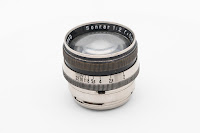





































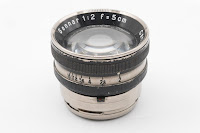

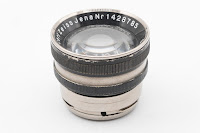






















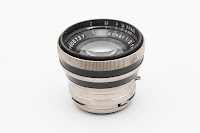






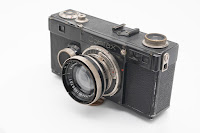







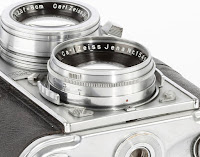
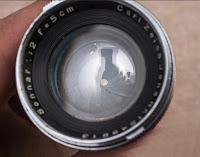
















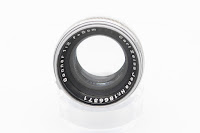




















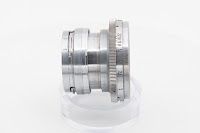




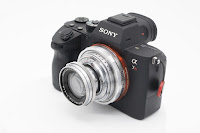

















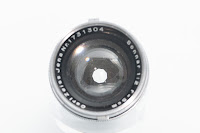












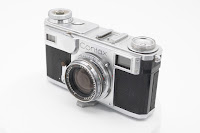






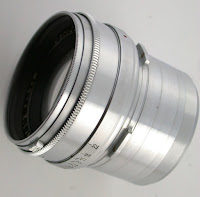

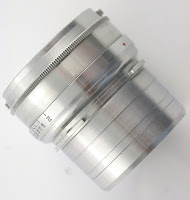
























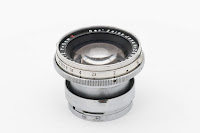


















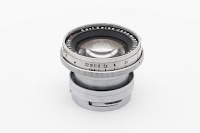
















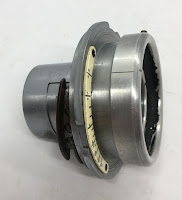

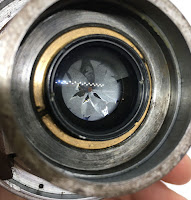








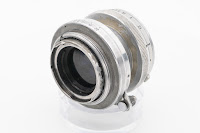












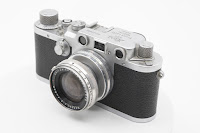






































































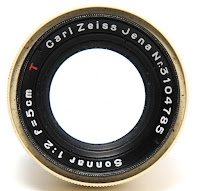





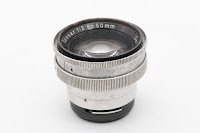



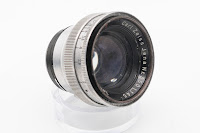

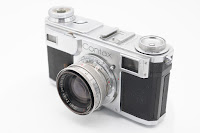




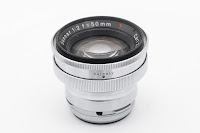
















































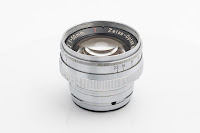









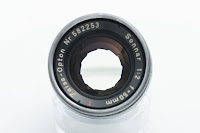







































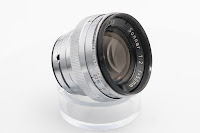
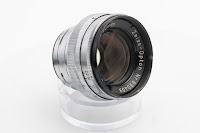
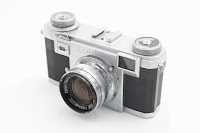

































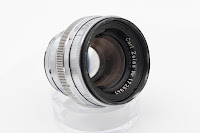





























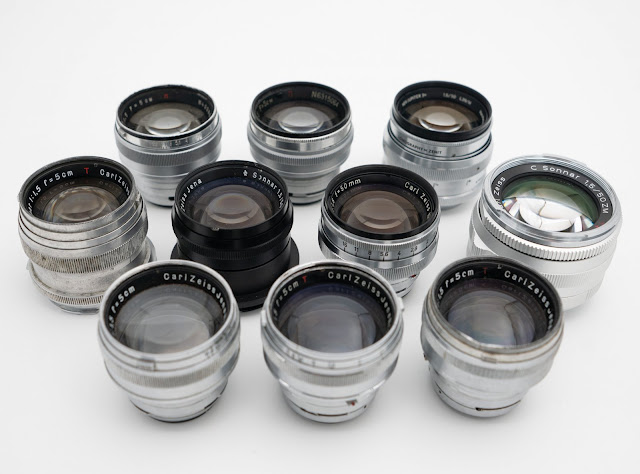


Hello just purchased a Sonnar 50 F2 T with LTM39. Serial 2686221. Performance is excellent
ReplyDelete